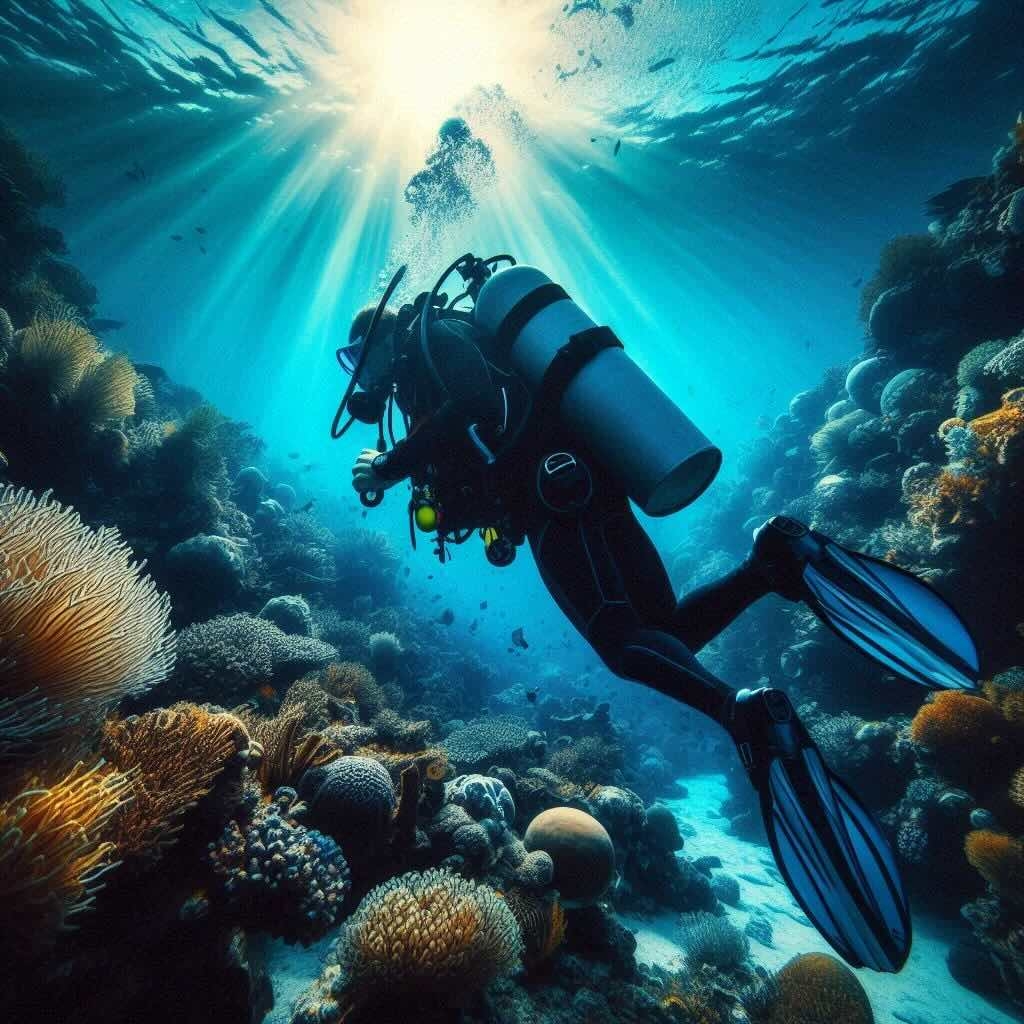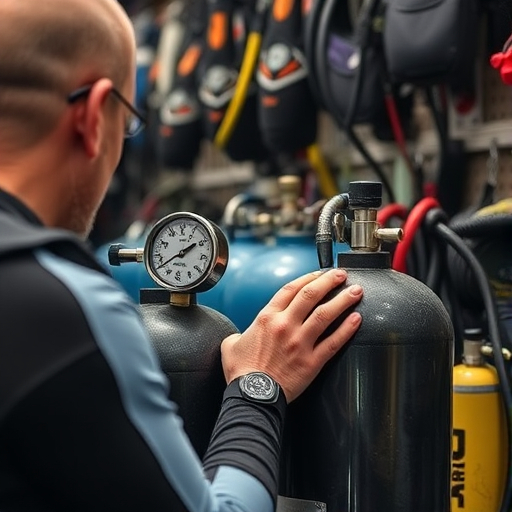
How to Clean A Snorkel Mask in 7 Steps
Learn the easy steps to clean your snorkel mask for crystal-clear underwater views.

Find the best scuba gear reviews, from dive computers and regulators to wetsuits and BCDs. Learn about equipment maintenance, choosing the right mask, and more.
Explore all
Learn the easy steps to clean your snorkel mask for crystal-clear underwater views.

Learn how to convert PSI and Bar pressures with this easy guide.

A straightforward guide to choosing the perfect dive watch for your underwater adventures.

Your essential guide to scuba diving regs—learn how they work, choose the right one, and dive safely with confidence.

Find out which suit suits you best!

Learn why you should check the PSI/Bar pressure of your scuba tank before a dive.

Learn how atmospheric diving suits let us safely explore the ocean's depths.

Learn the easy ways to calculate your weight to dive smoothly.

Discover how snorkels work, their types, and tips for safe use.

Two types of flags every diver and boater should know.

A go-to guide to choose your first scuba gear essentials for safe, fun diving.

Getting your first dive suit? Learn about types, what matters, and get important tips.

Learn easy steps to keep your wetsuit fresh, functional, and long-lasting for all your dives.
Scuba diving opens up a whole new world beneath the waves. The right equipment is key to safe and enjoyable dives. It is not just about convenience – it's your life support system underwater. Let's explore the gear that makes underwater exploration possible.
Every diver needs these essential pieces of equipment. They form the backbone of your scuba kit:
Your mask is your window to the underwater world. It creates an air space in front of your eyes, allowing you to see clearly underwater. Without it, everything would be a blur!
Key features:
Comfortable fit
Strong, tempered glass for safety and durability
Low volume for easy clearing
When choosing a mask, fit is crucial. A mask that leaks can ruin your dive. Try on different masks and check for a good seal. To test, place the mask on your face without the strap, inhale gently through your nose, and let go. A well-fitting mask should stay in place.
Tip: Invest in a quality scuba mask. It's worth spending a bit more for comfort and reliability.
Fins are your underwater engines. They help you move efficiently through water with less effort. Good fins can make the difference between an easy, enjoyable dive and a tiring struggle against currents.
Types:
Open heel: Worn with dive boots, great for cold water diving. They offer more foot protection and warmth.
Full foot: Lighter and more streamlined, perfect for warm water diving. They're easier to pack for travel.
Fin length and stiffness affect your kick. Longer fins offer more power but can be tricky in tight spaces.
Consider split fins for reduced leg strain on long dives. They're great for divers with joint issues or those prone to leg cramps. Choose based on water temperature and your comfort level.
Water conducts heat away from your body much faster than air. An exposure suit keeps you warm, allowing you to stay underwater longer comfortably. Exposure suits keep you warm:
Wetsuits: Made of neoprene, they trap a thin layer of water next to your skin. Your body heats this water, creating insulation. Wetsuits come in different thicknesses for various water temperatures.
Drysuits: Keep you completely dry. They're used for very cold water diving. Drysuits allow you to wear warm undergarments, making them ideal for extreme conditions.
Choose based on water temperature and your personal cold tolerance. Remember, being cold underwater isn't just uncomfortable – it can be dangerous, leading to faster air consumption and reduced focus.
Don't forget accessories like hoods, gloves, and boots for additional warmth in cooler waters.
A BCD is like a high-tech life jacket. It helps you control your buoyancy underwater and keeps you afloat on the surface. It's a crucial piece of gear for maintaining neutral buoyancy – the state where you neither sink nor float.
Look for:
Integrated weight systems
D-rings for attaching gear
Comfortable padding
There are two main types of BCDs:
1. Jacket style: Wraps around your torso. Good for beginners as they're intuitive to use.
2. Back-inflate: Keeps the air behind you. Offers better swimming position but can be trickier to control on the surface.
Try both styles to see which you prefer. Comfort is key – you'll be wearing this for entire dives.
Your regulator is the heart of your scuba system. It reduces the high-pressure air in your tank to a breathable pressure. Without it, the air in your tank would be unusable.
Components of a regulator system:
First stage: Attaches to the tank
Second stage: The mouthpiece you breathe from
Alternate air source: Backup for emergencies
Pressure gauge: Tells you how much air is left in your tank.
Low-pressure inflator hose: Connects to your BCD for inflation.
Quality matters when it comes to regulators. Don't compromise on this vital gear. Remember, your regulator needs regular servicing to ensure it's working properly. Don't skip on maintenance!
Dive computers track depth, time, and nitrogen levels. Modern dive computers track your depth, dive time, and nitrogen absorption. They help you dive safely within no-decompression limits.
Key features to look for:
Clear display
Multiple gas mixes for technical diving
Bluetooth for easy dive logging
A good dive computer helps maximize your time underwater safely.
These items enhance your diving experience:
A backup to your dive computer and a stylish accessory on land.
A small knife or cutting tool can free you from tangles or snags. Some divers prefer line cutters or trauma shears as alternatives to traditional knives.
Capture the beauty of the underwater world with a range of camera options.
Essential for night dives, a good dive light also brings out colors on daytime dives. The ocean absorbs colors as you go deeper, and a light restores the vibrant hues of marine life.
Proper care extends the life of your gear:
Rinse with fresh water after each dive
Avoid direct sunlight
Store BCDs partially inflated
Service regulators annually
Keep O-rings clean and lubricated
When selecting equipment:
Buy from reputable manufacturers
Try before you buy when possible
Consider renting to test different options
Focus on necessary features, not just bells and whistles
Exciting developments in diving gear include:
More accessible rebreathers
Smart masks with heads-up displays
Eco-friendly wetsuit materials
Advanced safety features in dive computers
With the right scuba diving equipment, you're ready to explore coral reefs, encounter marine life, and discover underwater wonders. Visit a local dive shop to learn more and try out different gear options.
Got questions? Find quick answers to common queries.
A basic set of new scuba gear typically ranges from $1,500 to $3,000. This includes mask, fins, wetsuit, BCD, regulator, and dive computer. High-end or technical diving equipment can cost significantly more. Used gear or package deals can offer savings, but be cautious about the condition and history of used life-support equipment.
Most manufacturers recommend annual servicing for regulators, or every 100 dives, whichever comes first. BCDs should be inspected yearly for leaks and valve function. Tanks require visual inspection annually and hydrostatic testing every 5 years in the US (regulations may vary in other countries). Always follow the manufacturer's guidelines for your specific equipment.
For beginners or occasional divers, renting can be a good option. It allows you to try different types of equipment and avoid the initial investment. If you dive regularly (more than 5-10 times a year), owning gear becomes more cost-effective. It also ensures you're always using familiar, well-fitting equipment. Consider buying personal items like masks, fins, and wetsuits early on for hygiene and comfort reasons.
While all scuba gear is important, the regulator is often considered the most critical as it supplies your breathing gas. However, the most important gear is what you're trained to use properly and maintain well. A quality, well-maintained mask, BCD, and dive computer are also crucial for a safe and enjoyable dive.
Most scuba gear can be traveled with, but there are restrictions on tanks and some cutting tools. Always check with your airline for specific regulations. Many divers choose to bring essential items like their mask, regulator, and dive computer while renting bulkier items like tanks and weights at their destination. Consider a dedicated dive gear bag for easier transport.
Subscribe to my newsletter and get notified when I share new diving tips, stories, and underwater adventures.